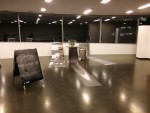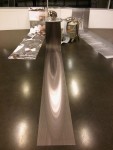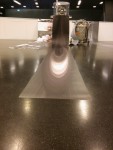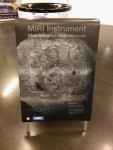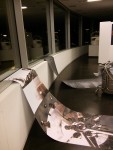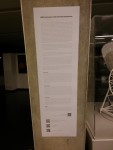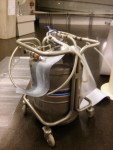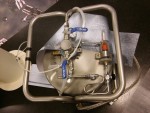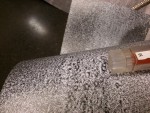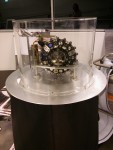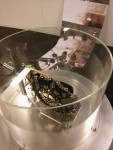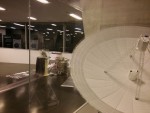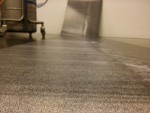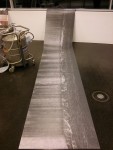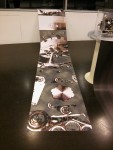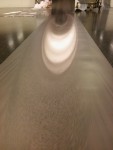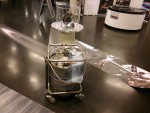The exhibition was created as a result of my collaboration with Max Planck Institute for Astronomy (MPIA) for the last two months, October and November 2016. It consists of a series of digital prints made by me and a filter wheel for the MIRI Instrument, developed here at MPIA by the Infrared Space Astronomy Group (led by Oliver Krause since 2005). The MIRI instrument was developed for the James Webb Space Telescope (JWST) which is an international collaboration. Institutions responsible for it’s development are NASA, the European Space Agency (ESA), and the Canadian Space Agency (CSA). Development of the project is managed by the NASA Goddard Space Flight Center. The main industrial partner is Northrop Grumman. The Space Telescope Science Institute will operate the telescope after launch in 2018. MIRI will be measuring mid-infrared electromagnetic frequency in JWST, and the artworks shown on the exhibition are abstract impressions of both mid-infrared astronomy and of aspects of the wheel as an instument. The wheel itself was an important inspiration for me as an artist – both by the way it was developed and by the science that will follow it’s measurements. It was crucial for me to have that instrument physcially here, in the exhibition’s space, to show how art and most outstanding technical advancement can coexist. Both the wheel and the prints are making up the exhibition together, being arranged as an insterdyscyplinary installation. Presence of this extraordinary invention gives new, important context for the abstract prints sourrounding it.
To be able to see deeper into the artworks (and the whole installation) it is important to understand science basics about the James Webb Space Telescope, MIRI Instrument and the filter wheel. Each work touches either one of the important aspects of the science that is expected to be done by the JWST, or the mid-infrared light spectrum that it will be measuring using MIRI Instrument or the specifics of the de
velopment of the filter wheel for MIRI.
Each of the exhibited prints has more detailed meaning behind it, but also they all share some features representing more general processes connected with MIRI Instrument and/or mid-infrared electromagnetic frequency of light that it will be measuring, such as:
- all prints are very long and stretched/deformed in some ways. I made them like this because of one of the properites of light, known as a Doppler effect. Light source that is going towards an observer appears a little bit shifted into the blue colour (it has higher frequency), while light source going away from the observer is shifted into the red colour (it has lower frequency). The fact that Universe is expanding since the Big Bang was discovered because of measurements of the light of the galaxies being shifted into red colour, escaping from us, no matter in which direction we look. JWST will be measuring the most shifted light, the one that was made by the first galaxies that formed after the Big Bang.
- noise that appears on part of the prints is representation of the cosmic background radiation, that is a relict of the infinite temperature that the Universe had in the moment of the Big Bang
- works are nearly black and white – but most of them are little bit shifted into more red colours (also because of the nature of the first light that the JWST will measure)
Mid-infrared
MIRI Instrument will be measuring wavelength range from 5 to 28 μm of the electromagnetic spectrum providing the high resolution spectroscopy in mid-infrared frequency. The work entitled Mid-infrared is an impression of the mid-infrared spectroscopy. JWST will make such measurements not only of the first galaxies that formed after the Big Bang, but also of exoplantes, yound stars and brown dwarfs allowing new detailed discoveries to be made. It will also see deeper into the dust clouds to measure objects hidden in them. The form of the print is partly showing some of the features of spectroscopic graphs, as well as the process of light disapearing from the spectrum possible to measure. It represents not only a spectroscopy itself, but also the phenomenon of light being dimmed by the dust cloud or because of its frequency shifting too much for currently operating instruments to measure it.
Liquid nitrogen
The work is dedicated to the enviorement in which the MIRI Instrument was designed to operate in. It has to be cooled down significantly (up to the temperature ~ 7K, which is -266 C), because any heat created by the instrument would influence the measurements of the mid-infrared light. Aboard the JWST satellite this cryogenic environment will be provided by a cooling machine. Even cables used in the wheel are made of a super thin stainless steel and not copper, because copper ones would create too much heat. On ground the instrument itself has to be put in the closed space, and kept constantly dry. Normal wet air would harm special components (since it was designed for very special conditions). It has to be connected with a vessel full of liquid nitrogen, that slowly evaporates and flows through a thin plastic tube into the wheel’s closed space behind the glass.
First galaxies
The print shows an impression of the first galaxy. Small drawing was stretched and deformed, but the spiral shape of the galaxy is still noticeable. Vibrant, pulsing background of the work shows the cosmic background radiation in it’s more intense, hotter form that it had before the first galaxies formed. The background is an impression of even farther point of Universe’s evolution, when there was no light yet and free electrons didn’t allow any light to travel freely through space. Only after the Universe cooled down enough for the electrons to be bound to protons, light could travel freely. After first stars (and galaxies afterwards) were formed, the first light we can see appeared.
Wheel
Not only the physics behind the construction of the filter wheel for the MIRI Instrument was important and interesting for me as an artist. As much important and astonishing for me was the construction of the wheel itself. The print Wheel is dedicated to the instrument’s design, it’s physicall appearance. It is also strechted and deformed, changing it’s visual form into radiation sources that it will be measuring.
Zofia Szczęsna Academy of Fine Arts in Krakow (Poland)
Max Planck Institute for Astronomy in Heidleberg, Infrared Space Astronomy
European Space Agency, MIRI Instrument
NASA, James Webb Space Telescope
- MIRI Instrument
- MIRI Instrument – First galaxies
- MIRI Instrument – First galaxies
- MIRI Instrument
- MIRI Instrument
- MIRI Instrument – description
- MIRI Instrument – Liquid nitrogen
- MIRI Instrument – Liquid nitrogen
- MIRI Instrument – Liquid nitrogen
- MIRI Instrument
- MIRI Instrument
- MIRI Instrument
- MIRI Instrument – Mid-Infrared
- MIRI Instrument – Mid-infrared
- MIRI Instrument – Wheel
- MIRI Instrument – First galaxies
- MIRI Instrument – Liquid Nitrogen
